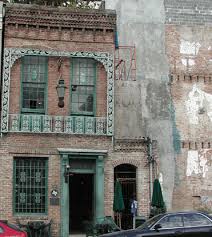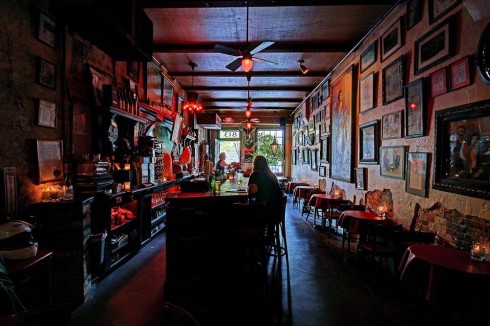MEMORABLE SUMMER NIGHT RENDEZVOUS’ AT LA CARAFE
La Carafe Building (circa 1860)– Houston, Texas
By Bob Vickrey
I sometimes sit in a little French café across the street from my house in Southern California enjoying my breakfast while listening to the piped-in music of Edith Piaf, and become quickly transported back to my college years where I first heard the haunting La vie en rose.
The rundown musty old bar in Houston was called La Carafe, and for several summers in the heyday of the 1960s, it provided the perfect meeting place for many of my former high school pals.
I remember the first night I entered the dark, mysterious La Carafe and promptly spotted several friends who were being regaled with stories by the bartender. I was immediately struck by the number of beautiful women in the room who all seemed to be speaking French. The international flavor of the place was quite a novelty for those of us that had barely crossed state borders.
La Carafe was housed in the oldest building in downtown Houston, and the century-old dilapidated structure gave the bar a portion of its unique ambience in this newly-bustling city. The fading facade of the building was in stark contrast to the glass skyscrapers beginning to emerge on nearby downtown streets, and offered one last hint of the city’s past glory. La Carafe was among the many thriving bars and restaurants in Old Market Square, a recently burgeoning area of remodeled buildings in the northern part of downtown along the banks of Buffalo Bayou.
The building dated back to about 1860, and was home to the Kennedy Bakery, which served baked biscuits to weary Confederate soldiers during the Civil War. It later served as a pony express station before eventually becoming the modern La Carafe in the 1950s.
The dimly lit room was small and intimate, with a chandelier hanging from the ceiling over the bar. Each of the small tables aligning the wall adjacent to the bar was accompanied by a lighted candle in the evenings, yielding just about the only light the place provided.
La Carafe had the coldest beer in town, which was poured into icy mugs dripping with thick frost that required a paper napkin underneath to catch the runoff. It had a jukebox in the corner of the room that offered just about the most eclectic taste imaginable. We listened to a diverse mix of Piaf, Sinatra, Jo Stafford, Hank Williams, and Louis Armstrong, and somehow, their songs always sounded so much better in that atmosphere than they did on our own radios. But the real magic of the place was how it ultimately forged new friendships when Saturday nights meant cozying up to a stranger in the crowded setting. It was our “Cheers” bar, long before there was a television show with the same name.
During those hot and humid Houston summer evenings, La Carafe provided a great spot for our friends to enjoy a cold beer and catch up on the latest gossip, and more importantly, to find out about everyone’s love life.
Occasionally, someone in the group would arrive with a date and choose a seat at a table in a private darkened corner. One friend suggested an unwritten rule should be to simply acknowledge the couple’s arrival, but not approach the table and interrupt their date. His advice served as our silent code of friendship.
Perhaps for a young man like me who had developed a strong interest in pursuing a writing career, La Carafe evoked what I imagined a Paris of the 1920s might have felt like—even if on this tiny scale. I imagined some small portion of this rarified atmosphere existed at the legendary Shakespeare and Company, the Paris bookstore located along the shores of the Seine River, and frequented by Henry Miller, Ernest Hemingway, F. Scott Fitzgerald and Gertrude Stein. I guessed that if those writers by some odd chance had visited our town, this dusty old relic would have surely been the spot where they congregated.
Several years later, I took my future wife to La Carafe, hoping she would sense some of the same atmosphere we had once discovered there, but I found the place had lost much of its luster for me. The crowds had dwindled considerably, and I no longer knew a soul in the place. My friends were all now getting married, and with their newfound responsibilities, hangouts became more of an infrequent option in succeeding years.
I asked myself if the place had changed, or if I had changed. I realized that I had likely romanticized the place a bit too much, but nevertheless, for one bright shining chapter in our young lives, La Carafe had provided moments of great joy and pleasure that some of us will long remember.
Bob Vickrey’s columns have appeared in the Houston Chronicle and the Ft. Worth Star-Telegram. He is a member of the Board of Contributors of the Waco Tribune-Herald. He lives in Pacific Palisades, California.
Comments
Leave a Reply
You must be logged in to post a comment.





